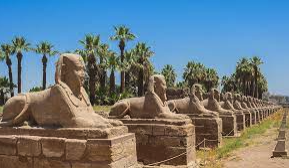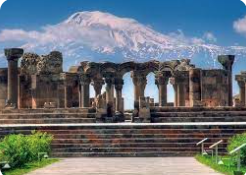Description
Karnak Temple
Karnak Temple, also known as the Karnak Temple Complex, is a sprawling and awe-inspiring complex of temples and buildings that once served as the religious center of ancient Thebes, the capital of Egypt during the New Kingdom. Located in Luxor, Egypt, about 2.5 kilometers (1.5 miles) north of the city center, Karnak is considered one of the largest and most impressive religious centers in the world.
Constructed over a period of approximately 1,500 years, from the Middle Kingdom (2055-1650 BCE) to the Roman period (30 BCE-395 CE), Karnak has been repeatedly enlarged and embellished by numerous pharaohs. The temple complex is dedicated to the Theban Triad of gods: Amun-Ra, the supreme deity, his consort Mut, and their son Khonsu.
The heart of Karnak is the Great Hypostyle Hall, a vast open-air courtyard lined with 134 monolithic columns in 16 rows. These columns, reaching heights of over 20 meters (65 feet), are adorned with intricate hieroglyphs and papyrus capitals, creating a mesmerizing sight.
Other notable structures within the temple complex include:
-
The Sacred Lake: A large pool of water that was used for ritual purification and sacred boat processions.
-
The Temple of Khonsu: A dedicated temple to the moon god Khonsu, featuring a hypostyle hall and a sanctuary.
-
The Avenue of Sphinxes: A processional way lined with sphinxes with the head of a ram, symbolizing Amun-Ra.
-
The Obelisk of Hatshepsut: An imposing obelisk of red granite, erected by the female pharaoh Hatshepsut in the 18th Dynasty.
Exploring Karnak Temple is like stepping back in time to the golden age of ancient Egypt. The sheer scale and architectural grandeur of the complex are truly breathtaking, offering a glimpse into the power and devotion of the ancient Egyptians.
Karnak Open Air Museum
Nestled within the vast and impressive Karnak Temple Complex, the Karnak Open Air Museum is a fascinating collection of ancient relics and structures that were once part of the temple complex but have been removed or unearthed. It’s a treasure trove of Egyptian history, showcasing the grandeur and craftsmanship of the ancient builders.
Here, you’ll discover a variety of architectural marvels, from towering obelisks and colossal statues to intricate carvings and sacred temples. The museum’s highlights include:
-
The White Chapel of Senwosret I: A beautifully preserved chapel dedicated to the pharaoh Senwosret I, adorned with intricate hieroglyphs and reliefs.
-
The Precinct of Mut: A sacred area dedicated to the goddess Mut, wife of Amun-Ra, featuring a hypostyle hall, a temple enclosure, and a sacred lake.
-
The Shrine of Tuthmosis III: A small but exquisite shrine dedicated to the pharaoh Tuthmosis III, featuring delicate reliefs depicting the pharaoh’s military triumphs.
-
The Bark Chapel of Thutmosis III: A unique boat-shaped structure that once housed the sacred boats used in religious ceremonies.
As you wander through the Karnak Open Air Museum, you’ll be transported back in time, imagining the vibrant rituals and ceremonies that once unfolded within these ancient structures. It’s a testament to the enduring legacy of Egyptian civilization and a must-visit destination for anyone seeking to delve into the depths of Egyptian history.
Luxor Temple
Luxor Temple, also known as the Temple of Luxor, is an ancient Egyptian temple complex located on the east bank of the Nile River in Luxor, Egypt. It is one of the most popular tourist attractions in Egypt, and is considered to be one of the most important archaeological sites in the world.
The temple was constructed over a long period of time, from the Middle Kingdom (2055-1650 BCE) to the Roman period (30 BCE-395 CE). It was built by a number of pharaohs, including Amenhotep III, Tuthmosis III, and Ramses II. The temple was dedicated to the Theban Triad of gods: Amun-Ra, the supreme deity, his consort Mut, and their son Khonsu.
The temple complex is divided into three main sections:
-
The Festival Colonnade: A long colonnade with 14 papyrus-shaped columns, which was used for the annual Opet festival.
-
The Hypostyle Hall: A vast hall with 32 columns, which was used for religious ceremonies.
-
The Sanctuary of Amun-Ra: The innermost sanctuary of the temple, which housed the cult statue of Amun-Ra.
The temple is decorated with numerous hieroglyphs and statues, which provide a wealth of information about ancient Egyptian religion and culture. It is a truly magnificent monument to the power and artistry of the ancient Egyptians.
Luxor Museum
The Luxor Museum, located in the heart of Luxor, Egypt, is a treasure trove of ancient Egyptian artifacts and a must-visit destination for those interested in Egyptian history and culture. It houses a vast collection of objects dating back to the Predynastic Period (c. 6000–3100 BC) to the Roman Period (30 BC-395 CE), including sculptures, sarcophagi, jewelry, papyri, and mummified remains.
The museum’s collection is organized chronologically, allowing visitors to trace the evolution of Egyptian art and culture over millennia. Highlights include:
-
The Amenhotep III colossi: Two colossal statues of the pharaoh Amenhotep III, measuring over 13 meters (43 feet) tall.
-
The Temple of Thutmosis III: A complete temple that was dismantled and moved to the museum from Karnak Temple.
-
The Mummy of Hatshepsut: The well-preserved mummy of the female pharaoh Hatshepsut, adorned with jewelry and amulets.
-
The Tomb of Senneferi: A beautifully decorated tomb from the New Kingdom, featuring scenes of daily life and religious rituals.
-
The Rosetta Stone: A multilingual inscription that helped decipher ancient Egyptian hieroglyphs.
The Luxor Museum is a fascinating and immersive journey through the ancient Egyptian civilization. Its well-curated collection and informative displays provide a unique glimpse into the lives and beliefs of the Egyptians, offering a deeper appreciation for their rich and complex culture.
Mummification Museum
The Mummification Museum, located in Luxor, Egypt, is a fascinating and informative museum dedicated to the ancient Egyptian practice of mummification. It provides a detailed and comprehensive look into the intricate process of preparing bodies for the afterlife, which was believed to be essential for eternal life.
The museum’s exhibits showcase the various stages of mummification, from the initial preparation of the body to the intricate wrapping process and the final placement in the tomb. Visitors can observe actual tools and materials used by ancient embalmers, and see detailed models and replicas of mummified bodies.
Through interactive displays and informative signage, the museum brings the ancient practice of mummification to life. Visitors can learn about the symbolism and beliefs associated with mummification, the significance of the different materials used, and the importance of ensuring the deceased’s preservation for eternity.
The Mummification Museum is a captivating and educational destination for those seeking to delve into the fascinating world of ancient Egyptian funerary practices. It offers a unique perspective on the beliefs and practices of the ancient Egyptians, providing a deeper understanding of their deep connection to the afterlife.
Avenue of the Sphinxes
The Avenue of Sphinxes, also known as Ramses Avenue, is an ancient processional way that once connected the Karnak Temple Complex to the Luxor Temple. It is a magnificent example of ancient Egyptian architecture and engineering, stretching for over 2.7 kilometers (1.7 miles) and lined with over 1,200 ram-headed sphinx statues.
Construction of the Avenue of the Sphinxes began during the reign of Amenhotep III in the 18th Dynasty, and was later extended by Ramses II in the 19th Dynasty. The sphinxes, with their imposing presence and intricate details, serve as guardians of the path, symbolizing the power and divinity of the pharaohs.
The Avenue of the Sphinxes is a remarkable remnant of ancient Egypt, offering a glimpse into the grandeur and artistry of this remarkable civilization. It is a must-visit destination for those seeking to experience the majesty of ancient Egypt.
Here are some of the key features of the Avenue of the Sphinxes:
- Length: 2.7 kilometers (1.7 miles)
- Number of Sphinxes: Over 1,200
- Material: Sandstone
- Deity Represented: Ram-headed sphinxes, symbolizing Amun-Ra, the supreme god of ancient Egypt
- Purpose: Processional way connecting Karnak Temple to Luxor Temple
- Historical Significance: A testament to the power and artistry of ancient Egypt
- Cultural Significance: A symbol of the enduring legacy of Egyptian civilization
The Avenue of the Sphinxes is a truly awe-inspiring sight, a testament to the engineering and artistic prowess of the ancient Egyptians. It is a must-visit destination for anyone seeking to experience the grandeur of this remarkable civilization.




Reviews
There are no reviews yet.